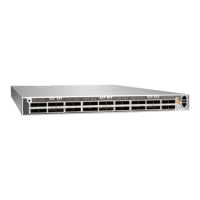1. (Recommended) Disable the port in which the transceiver is installed by including the disable
statement at the [edit interfaces] hierarchy level for the specic interface:
[edit interfaces]
set
interface-name
disable
LASER WARNING: Do not look directly into a ber-opc transceiver or into the ends
of ber-opc cables. Fiber-opc transceivers and ber-opc cables connected to
transceivers emit laser light that can damage your eyes.
LASER WARNING: Do not stare into the laser beam or view it directly with opcal
instruments even if the interface has been disabled.
2. Carefully unplug the ber-opc cable connector from the transceiver.
3. Cover the transceiver with a rubber safety cap.
LASER WARNING: Do not leave a ber-opc transceiver uncovered except when
inserng or removing a cable. The rubber safety cap keeps the port clean and prevents
accidental exposure to laser light.
4. Cover the ber-opc cable connector with the rubber safety cap.
Connect a Fiber-Opc Cable to the PTX10001-36MR
Before you connect a ber-opc cable to a PTX10001-36MR, ensure that you have taken the necessary
precauons for safe handling of lasers (see "Radiaon from Open Port Apertures Warning" on page 164
and "Laser and LED Safety Guidelines and Warnings" on page 161).
The PTX10001-36MR has opcal transceivers to which you can connect ber-opc cables.
To connect a ber-opc cable to an opcal transceiver installed in the PTX10001-36MR:
123

